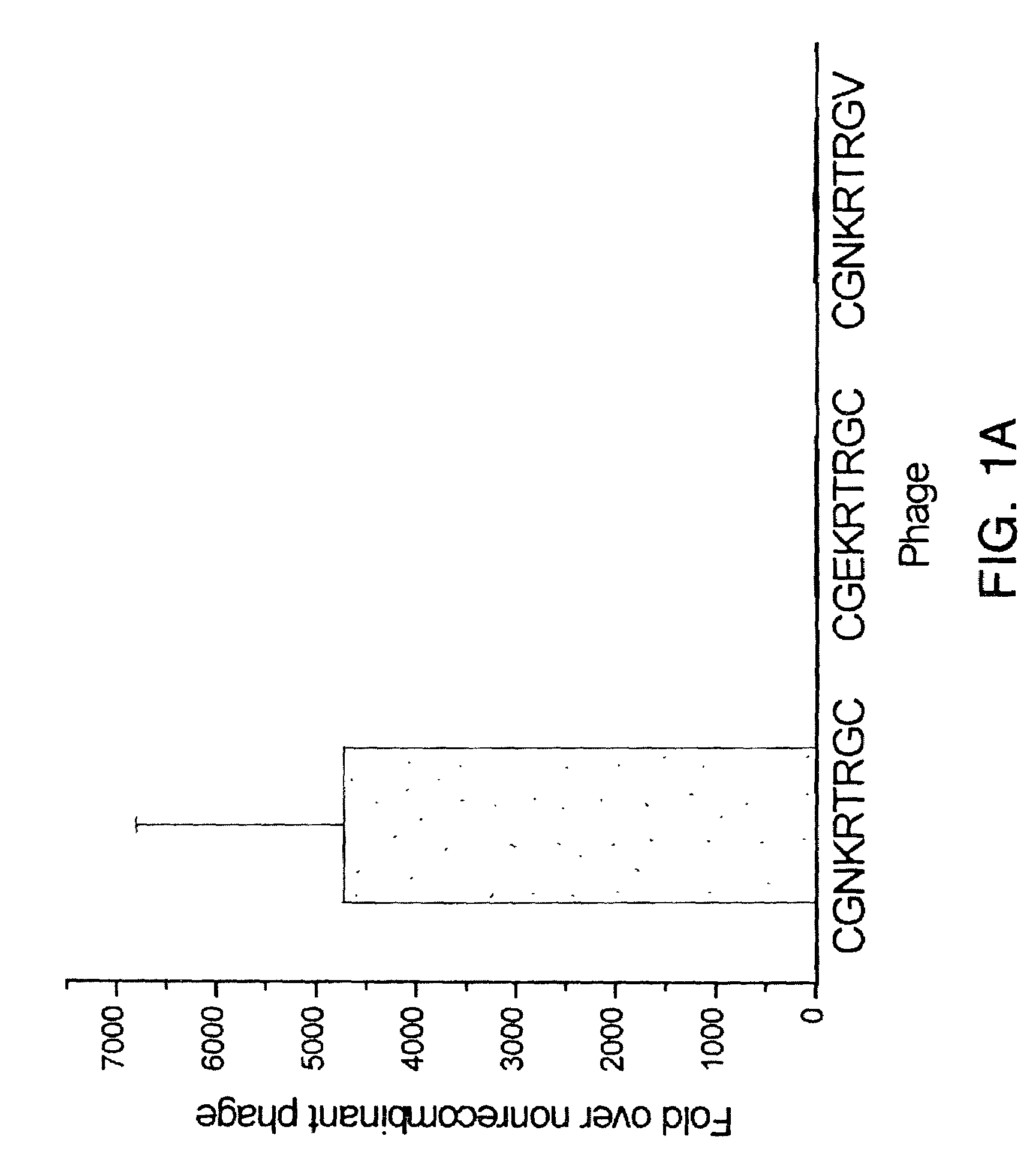Peptides that home to tumor lymphatic vasculature and methods of using same
a technology of tumor lymphatic vasculature and peptides, which is applied in the field of molecular medicine and drug delivery, can solve the problems of significantly affecting the quality of patient life, limiting the amount of treatment, and significant to cancer patient mortality, so as to and reduce the number of tumor lymphatic vessels
- Summary
- Abstract
- Description
- Claims
- Application Information
AI Technical Summary
Benefits of technology
Problems solved by technology
Method used
Image
Examples
example 1
Identification of Peptides that Bind to MDA-MB-435 Breast Carcinoma Cells In Vitro
[0103]This example describes identification of a peptide that selectively homes to MDA-MB-435 breast carcinoma xenograft tumors using ex vivo and in vivo selections.
[0104]Several ex vivo selections were performed with 435 tumor cell suspensions prepared from MDA-MB-435 breast carcinoma xenografts grown in nude mice, as described below. Anti-mouse CD31 was used to deplete the tumor cell mixture of blood vessel endothelial cells prior to rescuing phage bound to the CD31-negative cell population. By the third ex vivo round, the phage pool bound a tumor cell suspension approximately 350-fold over control, nonrecombinant phage. The ex vivo preselected phage pool then was subjected to an in vivo selection round by injection into the tail vein of a nude mouse bearing an MDA-MB-435 tumor. Phage were then rescued from harvested xenograft tumor tissue.
[0105]Selected phage were enriched 30-fold relative to nonrec...
example 2
Selective In Vivo Homing of Peptide CGNKRTRGC (SEQ ID NO: 1)
[0112]This example demonstrates that CGNKRTRGC (SEQ ID NO: 1)-displaying phage selectively home to MDA-MB-435 and KRIB human osteosarcoma tumors in vivo.
[0113]In vivo homing selectivity was analyzed essentially as follows. CGNKRTRGC (SEQ ID NO: 1)-displaying phage were injected into the tail vein of nude mice bearing either an MDA-MB-435 tumor, a KRIB osteosarcoma, a C8161 melanoma or an HL-60 leukemia cell xenograft. Phage subsequently were rescued from the respective tumors, as well as from several normal tissues (brain, kidney, liver, spleen, skin and breast).
[0114]As shown in FIG. 1C, CGNRTRKGC (SEQ ID NO: 1)-displaying phage homed to 435 and KRIB tumors in vivo. Although the strength of homing varied, the mean phage titer in tumor tissue was about 60-fold greater than for nonrecombinant phage in 435 tumors and 15-fold greater than for nonrecombinant phage in KRIB osteosarcomas. In contrast, the CGNKRTRGC (SEQ ID NO: 1)...
example 3
Internalization of the CGNKRTRGC (SEQ ID NO: 1)-Displaying Phage by Cells
[0117]This example demonstrates that CGNKRTRGC (SEQ ID NO: 1)-displaying phage are internalized by cells.
[0118]Increasing the time from the intravenous injection of the CGNKRTRGC (SEQ ID NO: 1)-displaying phage to rescue from the 435 tumors decreased phage recovery. To determine whether or not this decrease was due to internalization of phage by the cells, phage were rescued by lysing 435 tumor cells with a 0.5% solution of the detergent NP-40. As shown in FIG. 1E, 10 to 20 times more SEQ ID NO: 1-displaying phage were recovered with detergent than without detergent, indicating that phage were internalized by the tumor cells.
[0119]A fluorescein-conjugated CGNKRTRGC (SEQ ID NO: 1) peptide was utilized to further analyze cellular internalization and subcellular localization. Fluorescein-conjugated CGNKRTRGC (SEQ ID NO: 1) peptide and a fluorescein-conjugated control peptide containing three basic residues were sy...
PUM
| Property | Measurement | Unit |
|---|---|---|
| length | aaaaa | aaaaa |
| molecular compositions | aaaaa | aaaaa |
| fluorescent | aaaaa | aaaaa |
Abstract
Description
Claims
Application Information
 Login to View More
Login to View More - R&D
- Intellectual Property
- Life Sciences
- Materials
- Tech Scout
- Unparalleled Data Quality
- Higher Quality Content
- 60% Fewer Hallucinations
Browse by: Latest US Patents, China's latest patents, Technical Efficacy Thesaurus, Application Domain, Technology Topic, Popular Technical Reports.
© 2025 PatSnap. All rights reserved.Legal|Privacy policy|Modern Slavery Act Transparency Statement|Sitemap|About US| Contact US: help@patsnap.com



